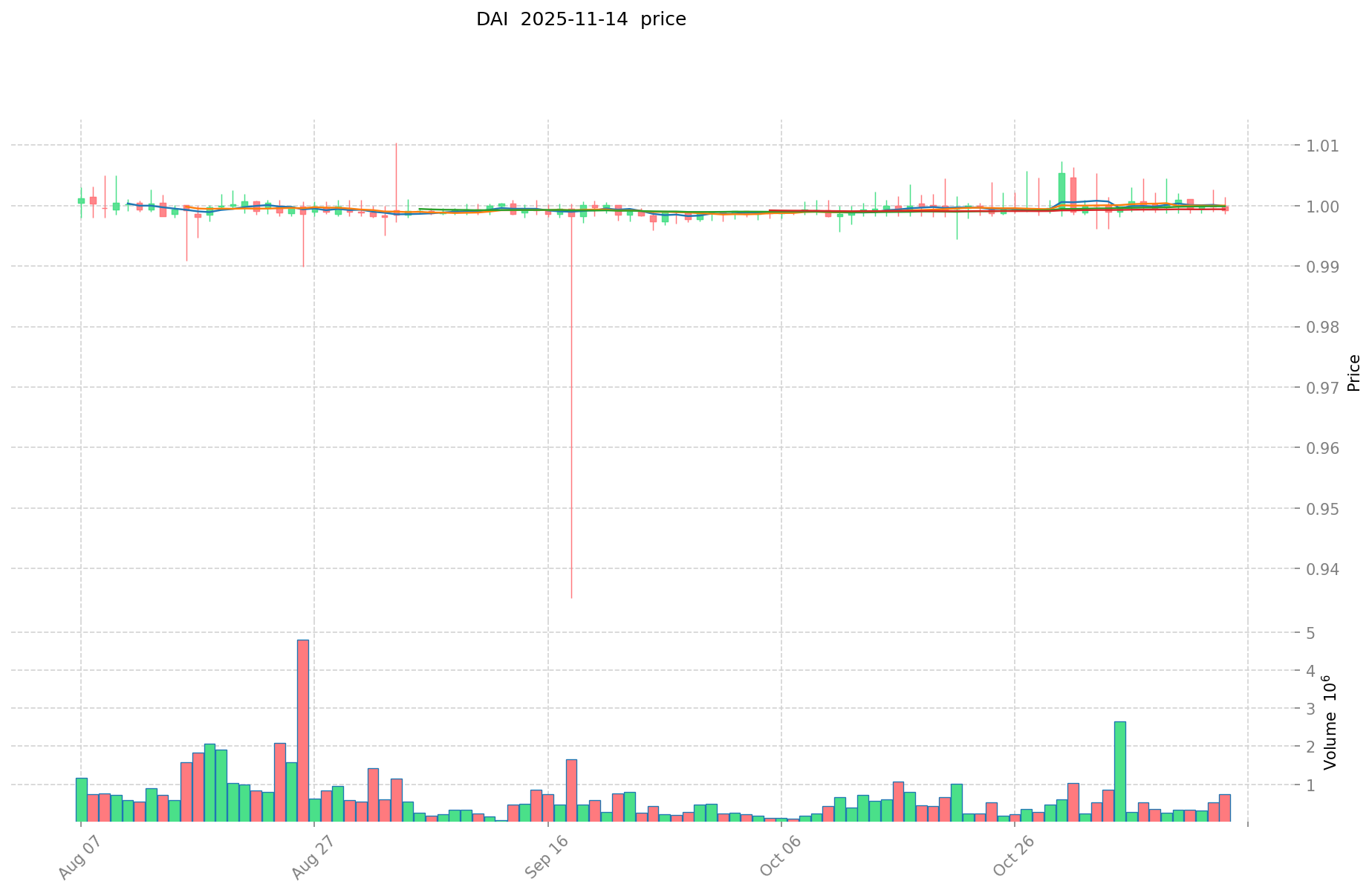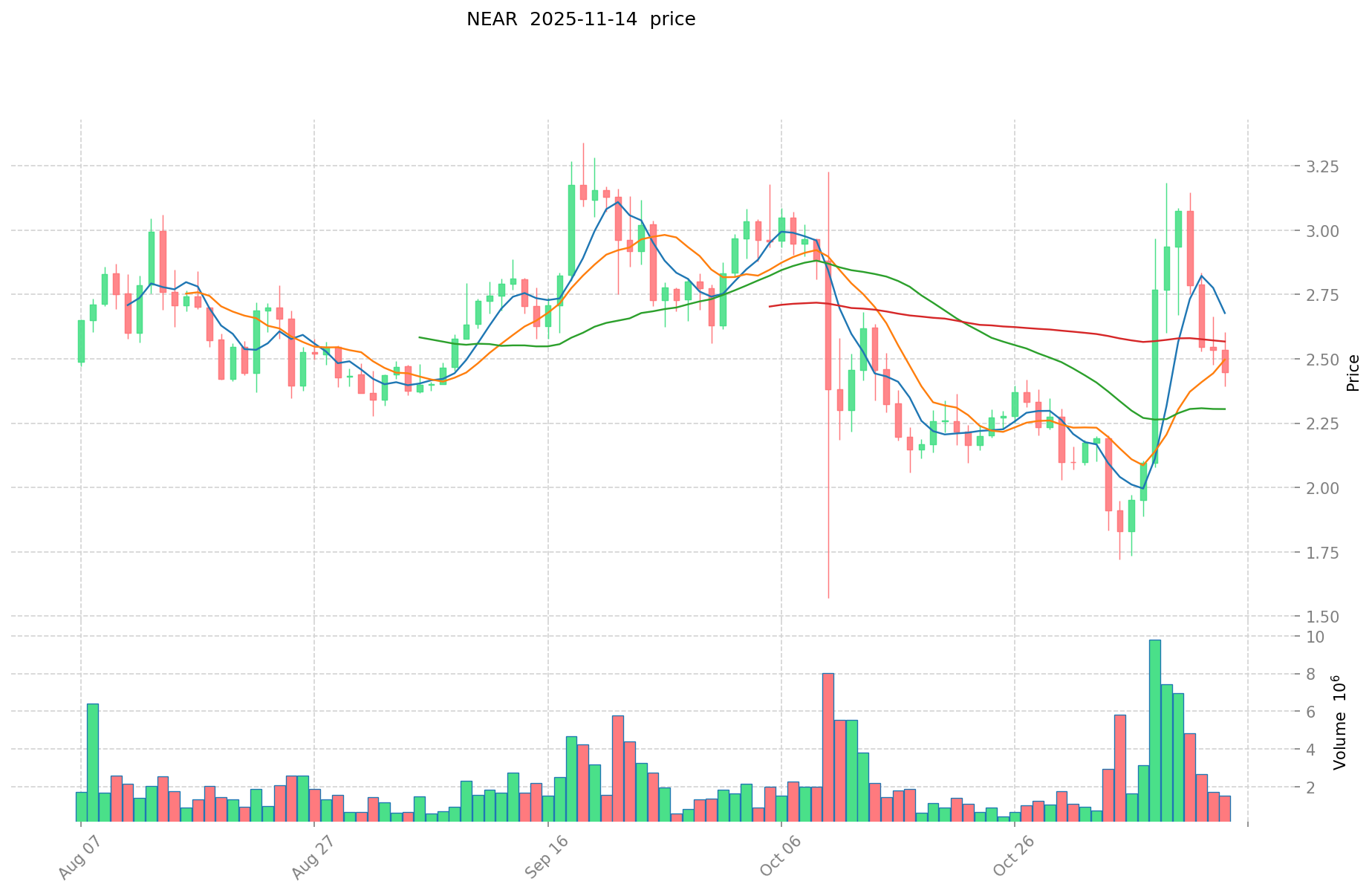DAI vs NEAR: Comparing Stablecoin Solutions for the Future of Decentralized Finance
Introduction: DAI vs NEAR Investment Comparison
In the cryptocurrency market, DAI vs NEAR comparison has always been an unavoidable topic for investors. The two not only have significant differences in market cap ranking, application scenarios, and price performance, but also represent different crypto asset positioning.
DAI (DAI): Since its launch in 2017, it has gained market recognition for its role as a decentralized stablecoin and DeFi infrastructure.
NEAR (NEAR): Introduced in 2020, it has been hailed as a highly scalable blockchain protocol, aiming to support fast DApp operations on mobile devices.
This article will comprehensively analyze the investment value comparison between DAI and NEAR, focusing on historical price trends, supply mechanisms, institutional adoption, technological ecosystems, and future predictions, attempting to answer the question investors care about most:
"Which is the better buy right now?"
I. Price History Comparison and Current Market Status
DAI and NEAR Historical Price Trends
- 2020: DAI reached its all-time high of $1.22 on March 13, 2020, likely due to increased demand for stablecoins during market volatility.
- 2022: NEAR hit its all-time high of $20.44 on January 17, 2022, possibly influenced by overall crypto market bullishness and growing ecosystem adoption.
- Comparative analysis: During market cycles, DAI has maintained relative stability as a stablecoin, fluctuating between $0.88 and $1.22. In contrast, NEAR has experienced more significant volatility, dropping from its all-time high of $20.44 to as low as $0.53.
Current Market Situation (2025-11-14)
- DAI current price: $1.00002
- NEAR current price: $2.36
- 24-hour trading volume: DAI $403,080.80 vs NEAR $5,037,307.56
- Market Sentiment Index (Fear & Greed Index): 16 (Extreme Fear)
Click to view real-time prices:
- View DAI current price Market Price
- View NEAR current price Market Price


II. Core Factors Affecting DAI vs NEAR Investment Value
Supply Mechanisms Comparison (Tokenomics)
- DAI: Stablecoin with a soft peg to USD, maintained through collateralization mechanisms; supply expands or contracts based on market demand
- NEAR: Inflationary model with maximum supply cap of 1 billion tokens, utilizing Proof-of-Stake consensus mechanism
- 📌 Historical Pattern: DAI's stability mechanisms help maintain its $1 peg during market volatility, while NEAR's controlled inflation and staking rewards create different price dynamics in bull/bear markets.
Institutional Adoption and Market Applications
- Institutional Holdings: NEAR has attracted institutional investors including a16z and Coinbase Ventures, while DAI is primarily utilized within DeFi protocols rather than held as an institutional asset
- Enterprise Adoption: DAI serves as a stable medium of exchange in DeFi applications and cross-border payments; NEAR focuses on Web3 applications and developer ecosystems
- Regulatory Stance: DAI faces regulatory scrutiny as part of the broader stablecoin sector, while NEAR generally experiences less direct regulatory pressure
Technical Development and Ecosystem Building
- DAI Technical Upgrades: Multi-collateral DAI system allows various assets as collateral; Maker governance continues refining stability mechanisms
- NEAR Technical Development: Sharding implementation for scalability; focus on developer-friendly environment with NEAR SDK
- Ecosystem Comparison: DAI dominates in DeFi lending and stablecoin use cases; NEAR excels in Web3 applications, NFT marketplaces, and cross-chain interoperability
Macroeconomic Factors and Market Cycles
- Performance in Inflationary Environments: DAI designed to maintain purchasing power during inflation; NEAR performance more correlated with broader crypto market cycles
- Macroeconomic Monetary Policy: Interest rates impact DAI's stability mechanisms and borrowing demand; affect NEAR through general crypto market sentiment
- Geopolitical Factors: Cross-border restrictions may increase DAI demand as a stable USD alternative; NEAR benefits from growing global Web3 adoption
III. 2025-2030 Price Prediction: DAI vs NEAR
Short-term Prediction (2025)
- DAI: Conservative $1.00 - $1.00 | Optimistic $1.00 - $1.00
- NEAR: Conservative $2.25 - $2.36 | Optimistic $2.36 - $2.86
Mid-term Prediction (2027)
- DAI may remain stable, expected price $1.00
- NEAR may enter a growth phase, expected price $2.49 - $4.59
- Key drivers: Institutional inflows, ETF, ecosystem development
Long-term Prediction (2030)
- DAI: Base scenario $1.00 - $1.00 | Optimistic scenario $1.00 - $1.00
- NEAR: Base scenario $4.38 - $5.28 | Optimistic scenario $5.28 - $7.07
Disclaimer
DAI:
| 年份 | 预测最高价 | 预测平均价格 | 预测最低价 | 涨跌幅 |
|---|---|---|---|---|
| 2025 | 1 | 1 | 1 | 0 |
| 2026 | 1 | 1 | 1 | 0 |
| 2027 | 1 | 1 | 1 | 0 |
| 2028 | 1 | 1 | 1 | 0 |
| 2029 | 1 | 1 | 1 | 0 |
| 2030 | 1 | 1 | 1 | 0 |
NEAR:
| 年份 | 预测最高价 | 预测平均价格 | 预测最低价 | 涨跌幅 |
|---|---|---|---|---|
| 2025 | 2.86044 | 2.364 | 2.2458 | 0 |
| 2026 | 3.7615968 | 2.61222 | 2.481609 | 10 |
| 2027 | 4.589148096 | 3.1869084 | 2.485788552 | 35 |
| 2028 | 5.17107756984 | 3.888028248 | 2.48833807872 | 64 |
| 2029 | 6.0243053688636 | 4.52955290892 | 3.850119972582 | 91 |
| 2030 | 7.071085046115012 | 5.2769291388918 | 4.379851185280194 | 123 |
IV. Investment Strategy Comparison: DAI vs NEAR
Long-term vs Short-term Investment Strategy
- DAI: Suitable for investors seeking stability, hedging against market volatility
- NEAR: Suitable for investors focused on ecosystem potential, Web3 growth
Risk Management and Asset Allocation
- Conservative investors: DAI: 80% vs NEAR: 20%
- Aggressive investors: DAI: 40% vs NEAR: 60%
- Hedging tools: Stablecoin allocation, options, cross-currency portfolios
V. Potential Risk Comparison
Market Risk
- DAI: Depegging risk, collateral volatility
- NEAR: High correlation with overall crypto market volatility
Technical Risk
- DAI: Smart contract vulnerabilities, collateral system stability
- NEAR: Scalability challenges, network stability
Regulatory Risk
- Global regulatory policies may have different impacts on stablecoins (DAI) and layer-1 protocols (NEAR)
VI. Conclusion: Which Is the Better Buy?
📌 Investment Value Summary:
- DAI advantages: Stability, DeFi infrastructure role, inflation hedge
- NEAR advantages: Web3 ecosystem growth, scalability potential, institutional backing
✅ Investment Advice:
- Novice investors: Consider a higher allocation to DAI for stability
- Experienced investors: Balanced portfolio with both DAI and NEAR, adjusting based on risk tolerance
- Institutional investors: Strategic allocation to NEAR for Web3 exposure, DAI for treasury management
⚠️ Risk Warning: The cryptocurrency market is highly volatile. This article does not constitute investment advice. None
VII. FAQ
Q1: What are the main differences between DAI and NEAR? A: DAI is a stablecoin pegged to the US dollar, while NEAR is a layer-1 blockchain protocol. DAI aims for price stability, whereas NEAR focuses on scalability and supporting decentralized applications.
Q2: Which cryptocurrency is more suitable for long-term investment? A: For long-term investment, NEAR may offer more growth potential due to its ecosystem development and Web3 focus. However, DAI provides stability and can be useful for preserving value during market volatility.
Q3: How do regulatory risks differ between DAI and NEAR? A: DAI, as a stablecoin, faces more direct regulatory scrutiny, particularly regarding its peg mechanism and collateralization. NEAR, being a layer-1 protocol, generally experiences less direct regulatory pressure but may be affected by broader crypto regulations.
Q4: What factors could drive the future price of NEAR? A: Factors that could drive NEAR's price include institutional adoption, ecosystem growth, technological advancements in scalability, and broader Web3 adoption.
Q5: Is DAI a good hedge against market volatility? A: Yes, DAI can be an effective hedge against market volatility due to its design as a stablecoin pegged to the US dollar, making it less susceptible to the extreme price swings often seen in other cryptocurrencies.
Q6: How do the tokenomics of DAI and NEAR compare? A: DAI has a supply that expands or contracts based on market demand, maintained through collateralization mechanisms. NEAR has an inflationary model with a maximum supply cap of 1 billion tokens and uses a Proof-of-Stake consensus mechanism.
Q7: What are the key risks to consider when investing in DAI or NEAR? A: For DAI, key risks include depegging events and collateral volatility. For NEAR, main risks involve high correlation with overall crypto market volatility and potential scalability challenges. Both face smart contract vulnerabilities and regulatory risks.
Share
Content